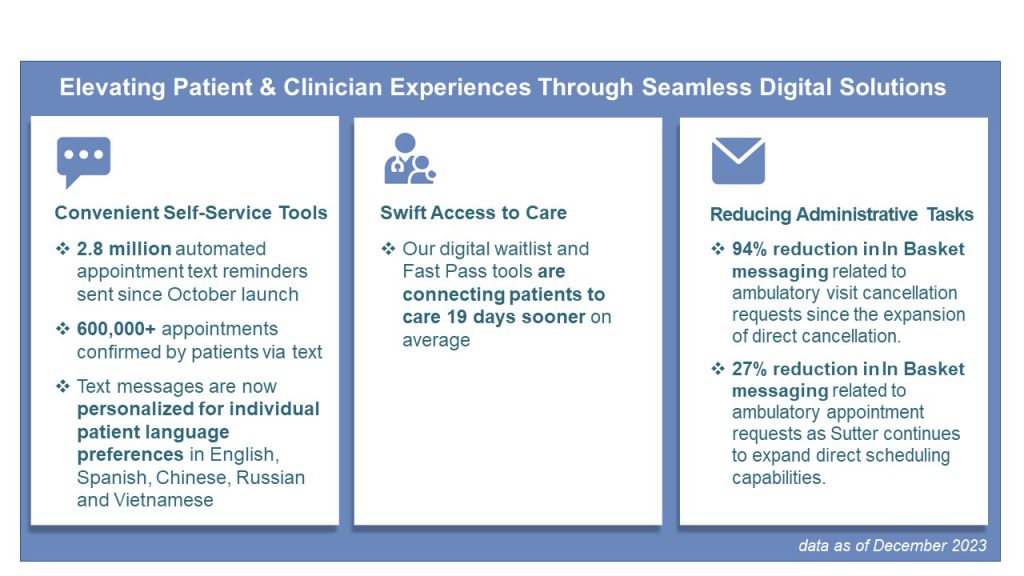As with every aspect of today’s consumer experience, adoption of digital healthcare tools is rapidly evolving. Healthcare organizations have responded, but one question has remained. Is it possible to meet consumer demands in a way that doesn’t negatively impact the providers who want more than anything to be of better service to patients?
One healthcare system, not-for-profit Sutter Health, made significant headway in its answer. In 2023, Sutter’s vision for digital transformation singularly focused on making healthcare more accessible and responsive to the needs of the patient and the provider.
A New Digital Front Door
In 2023, Sutter invested more than ever in systems, technologies and resources to support a more seamless and connected care experience through enhanced digital capabilities. Digital health teams focused on taking the most comprehensive and holistic view of the patient at every touchpoint. They examined appointment scheduling, referrals and health management, to discharge and billing. This approach helps those teams understand each patient’s needs, challenges and preferences.
“Our patients’ expectations around healthcare are increasingly shaped by how they access services in other areas of their day-to-day lives,” said Diedra Kramer, vice president of consumer strategy for Sutter Health. “We are proactively responding to these expectations with our digital vision and targeted strategies aimed at delivering an even more personal, connected and convenient experience.”
Sutter digital health team members refer to this retooling as a new “Digital Front Door.” It relies on addressing patients’ primary points of friction when accessing care and expanding their online self-service options when it comes to scheduling appointments or receiving reminders, for example.
This service change reduces no-shows and late cancellations, creating more available appointments and connecting patients to care sooner. To address concerns that simplifying the process on the front end for patients can potentially create more work on the back end for the care team, extensive planning and input from Sutter clinical experts are guiding each step in the implementation process. Additionally, these automated features decrease the volume of electronic health record messages to care teams, of which nearly half a million pertain to appointment requests and cancellations. Digital health leaders at Sutter Health anticipate a significant reduction in EHR messages related to appointment needs, with projections of nearly 300,000 fewer cancellation requests and almost 140,000 fewer appointment requests annually.
“We’re carefully planning the ecosystem needed to meet the modern consumer expectations of our patients,” says Jennifer Bollinger, senior vice president and chief consumer brand officer. “Implementing a digital front door strategy will empower patients, offering them more opportunities to interact and transact with us in ways that make Sutter easier to use.”
Part of these capabilities are made possible thanks to comprehensive upgrades to the EHR and the patient-facing My Health Online portal. These updates further optimize operational processes, elevate the overall patient experience and empower clinicians with the tools they need to provide exceptional care.
“Digital technology ought to simplify healthcare, ensuring user-friendliness and accessibility,” remarked Laura Wilt, chief digital officer at Sutter Health.” I commend our teams for their steadfast commitment to revolutionize healthcare delivery through digital innovation. Their collaborative efforts are addressing the ever-changing needs of our care teams and the diverse communities we serve.”
Innovations in Whole Person Health
“While digital strategy is typically associated with organizational and clinical improvements and efficiencies, our investments in digital access extend to whole person health,” noted Chris Waugh, Sutter Health’s chief innovation officer. “Developing empowering tools that are readily accessible helps us turn the corner from treating acute situations to preventing them.”
Two specific examples of Sutter’s work in this space are designed to offer unique support to teens and families. Scout by Sutter Health™ helps teens and young adults manage their everyday mental health needs and build resilience. To help promote more access to the tool for all youth, all subscriptions to the latest version are currently at no-cost for teens and young adults. Sutter has also partnered with other not-for-profit organizations, school districts, colleges and universities, employers and insurance providers to offer Scout at no cost.
Sutter also launched its Care Companion Healthy Pregnancy and New Baby digital care plans. These plans proactively support new parents with customized resources that complement the guidance they receive from their obstetricians, pediatricians and family medicine providers. Thousands of patients have enrolled in the New Baby plan since June and 66% of expectant mothers are currently enrolled in the Health Pregnancy care plan. Work is now underway to roll out additional care plans for different needs, too.
Given Sutter’s successes in 2023, what is on the horizon in 2024? Dr. Richard Milani, Sutter Health’s chief clinical innovation officer, shares one compelling example. Sutter is building a new care delivery model for managing chronic diseases such as hypertension and diabetes. Under this new fully digital model, patients will be able to manage their care at home, on their schedule, without the need for in-person visits. He explains that achieving blood pressure and diabetes control can be more easily attained by collecting measurements directly from home and having dedicated care teams reach out to make any necessary treatment modifications in a timelier manner based on the patient’s schedule.
“I am excited to see more digital transformations that support the needs of the patient and the provider, where the benefits are mutual,” he said. “In this way, Sutter can deliver more personalized and effective care to the populations we serve, while creating needed capacity for our busy providers.”





